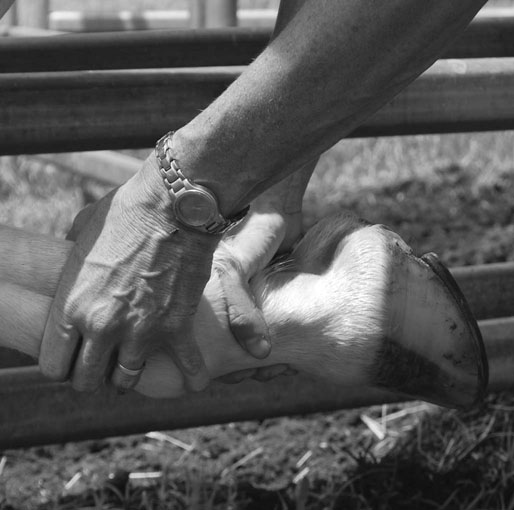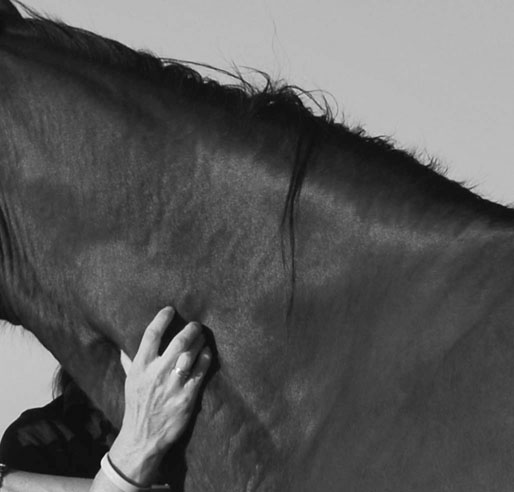Manual therapy refers to the practice of passive or assisted movement techniques applied by the therapist to address pain and impairments in the articular, neural and muscle systems.1 Manual therapy is applicable to the athletic horse when the animal’s performance is affected by pain and impairment, and may include joint manipulation and mobilization to articular and neural tissue, and stretching and massage to soft tissues. Mobilization and manipulation are defined by the rate and depth of application of thrust to the joint, and in research they are often termed spinal manipulative therapy (SMT). There are various forms of massage techniques and stretching. Manual therapy is well established clinically for the management of pain and impairment arising from the vertebral column in both man and the horse. Early beliefs regarding the mechanism of action for manual therapy on the spinal articular system included biomechanical effects of mobilization, and reduction in hypertonicity of paraspinal musculature. Evidence for these effects is not secure.2 Contemporary research suggests the pain-relieving effect of manual therapy is due to neurophysiological mechanisms. Inhibitory pathways descending from higher centers in the central nervous system, and neural inhibitory systems at various spinal cord levels, are stimulated by afferent input from specific locally induced movements such as mobilization and manipulation.3 This may result in hypoalgesia. There are also sympatho-excitatory effects associated with these techniques.4 Mobilization to L4/5 vertebral level articulation resulted in side-specific sympathetic nervous system changes being recorded.5 Similar hypoalgesic effects to that seen in spinal manual therapy are imparted when mobilization is carried out to the extremity joints.6 There is evidence that passive mobilization to the articulations of the knee in humans and rodents produces widespread and local hypoalgesic effects.7 Despite the fact that SMT is used clinically in horses and humans, views on the efficacy of SMT is mixed. Systematic reviews conclude that SMT used alone in man is not superior to other forms of treatment for acute or chronic low back pain.8,9 In conclusions of a randomized trial,10 SMT and motor control interventions both produced better short-term function than general exercise for back pain. However, this was not the case for medium or long-term effects. In another randomized clinical trial of individuals with chronic low back pain, supervised exercise was shown to be better than spinal manipulation or home exercises for trunk muscle function and patient satisfaction, but no different for pain, disability improvement in general health status and medication use.11 For mechanical neck pain, manipulation or mobilization alone showed non-significant benefit on pain relief when assessed against placebo, control or other treatments.12 Another group, however, showed short-term analgesic effect for neck pain following spinal mobilization or manipulation. Further, multimodal physical therapies that did not include manual therapy did not provide better pain relief than a control, whereas multimodal physical therapy that included spinal manual therapy provided pain relief that was better than a control.13 In the horse, high velocity, low amplitude thrusts directed perpendicularly to thoraco-lumbar vertebrae resulted in increased dorsoventral displacement of the trunk during passive spinal mobilization.14 Gomez-Alvarez and colleagues15 reported increases in spinal passive mobility after SMT, but these were decreased three weeks later compared to before treatment status. Mobilization when used in combination with exercise has been shown to be useful for the extremity joints.16 The selection of systematic reviews and randomized clinical trials quoted seem to favor manual therapy for the spine and extremities as part of multimodal intervention, especially when combined with exercise. In the athletic horse, back pain or sacroiliac pain is a common cause of poor performance.17 Here, spinal mobilization techniques may be useful for short-term pain modulation of symptoms arising from the vertebral column. According to the evidence, combining SMT or manual therapy techniques with exercise will give the best outcomes. Exercise concepts in equine physiotherapy will be discussed further in this chapter. A specific example where spinal manual therapy may be useful is where there is pain and dysfunction arising from the facet joints (single segment or group) in the thoracolumbar region of the horse’s back. Local and specific passive movements applied to these segments can assist in restoring movement and function through hypoalgesia, followed by appropriate exercises to maintain this functional benefit. Examples where mobilization to extremities may be useful in the athletic horse is where there is injury to, or osteoarthritis in, the metacarpophalaneal joint. Mobilization, or articular gliding movements can be applied to the articulation between the metacarpus and the proximal phalanx (Fig. 62.1). These mobilizations do not reverse any degenerative changes that may be present,18 but may induce hypoalgesia, therefore potentially allowing specific exercises to be effective at helping to restore function following the technique. Spinal or extremity directed manual therapy is contraindicated if there is non-weightbearing lameness (fracture/ infection), osteomyelitis, ankylosis, bleeding disorders, ataxia +/− upper motor neurone signs.18,19 SMT is also delivered with caution in cases where it is not yet established if back pain or poor performance is coming primarily from the vertebral column. Back pain is often secondary to another lameness, dysfunction or pathology in the horse’s limbs, or may be associated with medical conditions such as exertional rhambdomyolysis and thrombosis of caudal aorta or iliac arteries.17,20 The primary cause of the lameness must be diagnosed and treated by a veterinarian before the secondary back pain is addressed. Massage is practiced widely amongst many professionals involved with management of sporting injuries in the equine field. As is the case for manual therapy, many of the massage techniques applied to horses have been derived from human clinical techniques. Types of massage techniques include petrissage, effleurage, tapotement and frictions. Massage can be considered a manual therapy, although the area to which it is delivered is less specific than SMT. There is limited data as to the possible mechanism of action of massage.21 Proposed mechanisms include: increased muscle compliance, changes in circulation, hormone levels and psychophysiological parameters. However, this is all still inconclusive. Neurological effects may result from mechanical pressure via the increase or decrease of neural excitability as measured by the Hoffman reflex, but this has only been measured in petrissage.21 The type of massage technique delivered may also affect the mechanism of action. Despite its purported benefits and frequent use in the athlete, evidence for the efficacy of massage is scarce.22 There is no clear evidence that massage can improve performance, enhance recovery or prevent muscular injury.21 However, the large range of different massage techniques makes it difficult to combine results to get a good overall picture of massage.21 A Cochrane database systematic review states that in humans massage may be beneficial for low back pain when combined with exercises and education.23 A recent randomized controlled trial found that massage therapy may be effective for treating chronic back pain in people.24 Randomized controlled trials have shown moderate levels of evidence for the use of massage to facilitate recovery from repetitive muscular contractions associated with strenuous exercise.25 However, the overall consensus from the research is that further investigation using more standardized techniques and protocols is necessary to more conclusively demonstrate the efficacy of massage for musculoskeletal injury and sports performance.22,25 Horses with pain and dysfunction in the epaxial musculature or the vast gluteal musculature may indeed benefit from massage techniques that could improve muscle compliance and decrease pain. An example is quoted by Hill and co-worker26 where a goal of training young horses could be to create an earlier maximal protraction of the hindlimb, which may result in an increase in stride length. Massage (petrissage and effleurage) was applied to the caudal hindlimb muscles in eight horses and resulted in a significant increase in both passive and active hindlimb protraction.26 Figure 62.2 shows application of a massage technique. Deep friction massage has been proposed as an effective management for tendinopathy, which occurs frequently in the equine athlete; however, efficacy has not been confirmed as an isolated technique.27 There is suggestion that stretching before or after exercise can have negative effects on performance, especially in strength and power activities. Maximal isometric voluntary contraction (MVC) of a muscle was seen to be impaired following prolonged-hold (5 x 120 seconds) passive stretching to the plantar flexors.28 Taylor and colleagues29 surmise that the negative effects of stretching reported in research occurred because stretching routines studied were dissimilar to that practiced by athletes. These authors reported that the implementation of a dynamic sports-specific warm-up routine following the stretching negated the detrimental effects of stretching on jump height and sprint time, in human athletes. Stretching may be beneficial for flexibility and reducing muscle soreness. Thirty seconds of therapist-applied passive stretch to hamstrings resulted in an increased in hamstring flexibility in healthy human subjects.30 It has also been suggested that stretching may reduce the amount of muscle soreness felt following exercise31 therefore making recovery easier. Eccentric loading stretch to the tendo-achilles in humans has been found to be a successful treatment for mid-substance tendinopathy.32 A recent equine study looked at the effect of stretching on stride length and ROM in trot and found that stride length was not affected by stretch.33 There were in fact some negative effects on range of joint motion following a more frequent stretching regime of six times per week. This may have implications on how frequently a stretching program should be carried out. Range of motion however, was measured with skin markers, thus results may have been affected by skin movements over the joints. It is clear that further research into the effects of stretching on equine athletic performance is required. Weir and colleagues28 suggest that the effects of stretching are due to changes in the mechanical properties of muscles. In sustained static stretching, Kubo and co-workers34 measured MVC after 10 minutes of static stretch to gastrocnemius and elongation of tendon via ultrasound. They found that there was no change in MVC, decreased viscosity of tendon, but that there was increased elasticity.
Manual therapy and exercise for athletic horses
Manual therapy
Background
Mechanism of action
Efficacy
Indications and contraindications

Massage
Background and mechanism of action
Efficacy
Indications
Stretching
Background and efficacy
Mechanism of action
![]()
Stay updated, free articles. Join our Telegram channel

Full access? Get Clinical Tree


Manual therapy and exercise for athletic horses

